Webinar promotion is a crucial part of the webinar process, but the webinar promotion tips in this article go beyond just getting attendees to join.
Effective webinar promotion can also increase audience engagement and settle the nerves of webinar hosts. Promotion allows you to fill your audience with the right people and get closer to them.
For example, before promoting any event, I like to engage with potential attendees and find out what they want to hear from me.
For this article, I connected with seasoned webinar hosts to learn how to promote a webinar so you can run a successful event. Because no matter how great the content of your webinar is, it doesn‘t mean much if there’s nobody there to hear it.
So, grab your free webinar planning kit, and let’s get started.
Table of Contents
- The Benefits of Promoting Your Webinar
- How to Promote Webinars
- Tips for Establishing the “Why” Behind Your Webinar
- Webinar Promotion Tips Using Email
- Webinar Promotion Tips That Use Your Website
- Webinar Promotion Tips for Marketing Channels
- Webinar Promotion Tips Using Your Network
- Best Practices to Get the Most Out of Your Webinar Promotion
.png)
Free Webinar Planning Kit
Run better webinars with this kit, including the following assets:
- Guide on Building a Webinar
- Marketing & Sales Alignment Strategies
- Webinar Planning & Strategy Template
- Interactive Webinar Planning Checklist
Download Free
All fields are required.
.png)
The Benefits of Promoting Your Webinar
The benefits of promoting your webinar are plentiful. In fact, without any promotion, people won’t see it at all. Promoting your webinar can be as simple as telling your customers and setting up full marketing campaigns dedicated to driving webinar attendees.
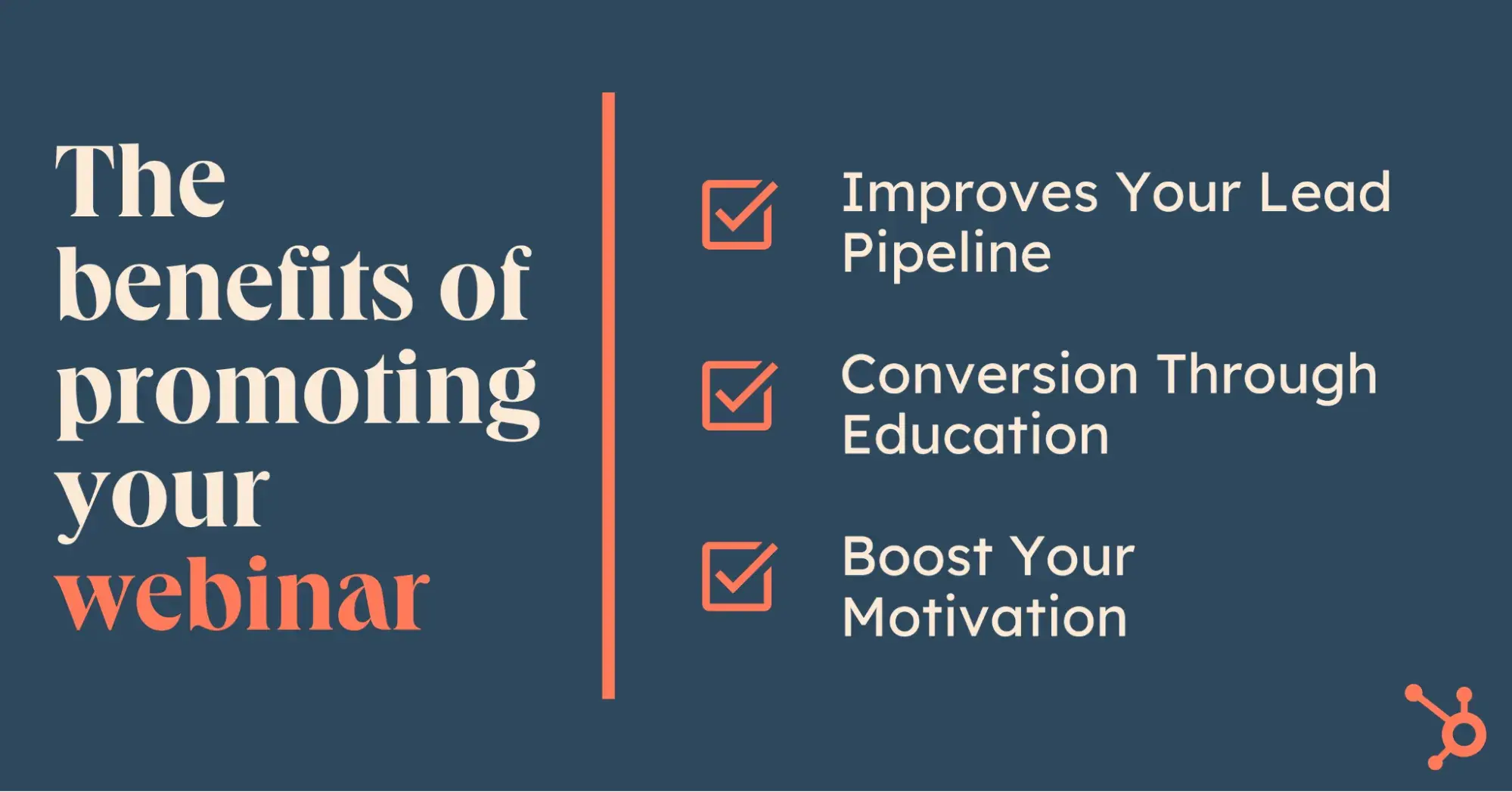
Improves Your Lead Pipeline
Everyone who attends your webinar is likely someone you should include in your lead pipeline. The webinar itself is a valuable asset, and if done well, your audience will be desperate to attend live or download it after the event.
Your webinar is often an exchange of access for an email. Once you’ve got the prospect email, you can nurture them through your lead pipeline.
You can encourage the email exchange by offering resources, supporting documentation, or just the recording emailed after the event.
Conversion Through Education
A webinar is generally educational. By educating your audience on a topic you’re passionate about, you can showcase your love of the subject and your knowledge and position yourself as the expert.
Through education, you raise awareness of a solution your audience needs. As a result, you will convert from your webinar, turning passive webinar viewers into active clients.
Conversion through webinars will not make you feel like you’re “being sales-y,” which is ideal for those who don’t like sales.
Boost Your Motivation
If you’re hosting a webinar, maybe for the first time, you might feel a bit nervous. I’ve joined live talks in the past, and my approach to webinar promotion is that if I can help get more people to attend the event, I will feel personally better, a little more accomplished, and more motivated.
During the promotion phase, I might ask people what relevant questions they have so I know to bring them up during the webinar. This is motivating because I can research more about the topic if I need to; I know what people want and that I will meet their needs.
How to Promote Webinars
- Choose a topic that straddles the line between broad and actionable.
- Ask your audience what they want from you.
- Think about other marketing tactics when creating your topic.
- Establish your goals.
- Set a registrant goal that will actually result in your desired number of attendees.
- Remind your audience about the webinar.
- Send a thank you email and registration confirmation.
- Send value-building reminder emails.
- Send two final reminder emails.
- Create an informative landing page.
- Blog about your webinar.
- Leverage your homepage.
- Give attendees something special.
- Run contests on social media that also promote the webinar.
- Market your webinar using social media.
- Don't be afraid of paid media.
- Market your webinar through your speakers.
- Use speaker headshots to promote your webinar.
- Partner up.
- Choose the right day of week.
- Choose the right time of day.
- Set calendar reminders.
- Use the best video conferencing tools to ensure a smooth video experience.
- Don’t be afraid to be yourself and be entertaining.
- Host mini Q&A sessions.
- Create clips and teaser content.
- Don’t gatekeep your most valuable webinar assets and points.
Tips for Establishing the “Why” Behind Your Webinar
Your webinar likely aims to educate your audience on a particular topic. If you're hosting a webinar, clarity on why you’re creating it, who it’s for, what you want them to get out of it, and what you want to get out of it will help you create the right messaging for webinar promotion.
Here are my top tips for the planning phase so you can nail how to market your webinar.
1. Choose a topic that straddles the line between broad and actionable.
It‘s really hard to get people to attend your webinar if your topic stinks. Try to select a topic that’s broad enough to attract a large audience yet targeted enough to provide actionable advice that attendees can implement the second they hop off your webinar.
For example, Unbounce ran a webinar with conversion rate optimization as the overarching theme (because what marketer doesn’t want to optimize?) but with a focus on landing page copy and design.
The topic (conversion rate optimization) is really broad, which means:
- Everyone wants it.
- It’s likely to be highly engaged.
- It’s too much to cover in a webinar and could lead to overwhelm.
This is where the actionable topic and focus come in. Landing page copy and design as a focus is:
- Targeted.
- Highly desirable and important.
- Actionable within one webinar without being overwhelming.
2. Ask your audience what they want from you.
One way to identify a topic is simply to ask! Even if you know what your audience wants, you can use this to drum up engagement before the event. You’ll likely learn more about what your audience wants, and the beauty of a webinar is that you can weave in ideas if you know what people want ahead of time.
I did an audio event, much like a webinar with Kendra Noel, and we promoted the event early on via social media. We wanted to hear exactly what our audience wanted so we could deliver it. Posts, much like the one pictured below, asked audiences to get in touch and ask questions in the comments.
Our posts collectively earned more than:
- 40 comments on socials.
- 28 shares.
- Reach in the tens of thousands.
This event was the first-ever for Noel and me, yet we had over eighty people in attendance at any time. Those who took the time to comment on our social media posts were among the most engaged during the event.

Why this tip is effective: In some ways, it’s evident that engaging your audience will lead to more registrations, but engaging the audience early on isn’t just about attendee lists for me. It’s more about getting some early conversation so I can prepare my webinar to be as useful as possible, solving real problems and queries that people have. I like how secure and confident this makes me feel when I deliver any webinar.
3. Think about other marketing tactics when creating your topic.
Awareness of other marketing tactics is extremely helpful when choosing a webinar topic. This leads to effective webinar promotion across marketing channels, such as social media, and also helps with post-webinar promotion.
Post-webinar promotion is where I see a lot of companies going wrong. What typically happens is they promote a webinar before the event, they host and record the webinar, there are follow-up emails shortly after, and then nothing.
The issue with this is that your webinar — providing it’s not extremely reactive to a timely event — is an asset you can use again, especially if you’ve considered your webinar a long-term asset from the beginning.
I ran a search on Google for “business intelligence webinar,” a keyword that has 90 searches per month. As pictured, BrightTALK and Kocho rank for this search term with webinars.

This is no coincidence. It’s clear they’ve done their research and considered the long-term value of their webinars.
To get the most out of their webinar promotion, BrightTALK and Kocho have considered the:
- Topic of the webinar.
- Value added to Google.
- Webinar title to include keywords.
- SEO factors including title tags, meta descriptions, headings, URLs, and more.
Combining the above ensures that these websites can rank on Google with recorded webinars that earn clicks and likely leads after the event without additional work.
Why I like this: I’m an SEO consultant, so I will always appreciate it when companies consider SEO in their webinar promotion. Generally, this is a huge gap that many companies miss. Instead of getting the most out of their webinar after it’s done, they use it once and forget to market it later as a lead-generating asset.
Once you’ve got the page live, and the SEO portion done, you can get views to your webinar at no extra effort.
4. Establish your goals.
Having a goal will inspire you to hit it and help you measure success.
A great example of a webinar goal is HubSpot’s attempt to break the Guinness World Record for webinar attendees.
HubSpot knew they’d have to hit 10,899 attendees when planning this event.
World Records aside, there are many reasons why you should set a goal. In theory, you're not putting on a webinar for the fun of it. You want it to contribute toward lead generation and brand awareness.
For this reason, consider what your marketing goals are and then decide how you want this webinar to contribute toward it.
Note: Just because people register for your webinar does not mean they will attend. This brings us to our next tip.
5. Set a registrant goal that will actually result in your desired number of attendees.
Webinars typically get 35% to 45% of pre-registrants to attend the live event. To determine how many registrants you need, think ahead to how many actual attendees you want.
Continuing with the Guinness World Record example in the previous tip, based on the typical figure of 35% to 45%, HubSpot knew they needed 10,899 attendees.
So, using some backward math, HubSpot needed to shoot for more than 31,140 registrants to meet the attendance goal.
You should track performance at least weekly to see whether your marketing efforts are moving the needle towards that registrant goal. That way, if you need to dial up your promotion due to low initial registration numbers, you'll know how to fix it.
Why I like this: Numbers help qualify efforts, keep marketing on track, and bring data to the table. Without it, you’re really just hoping that your webinar is going to work out. I highly recommend having something measurable during the webinar promotion process so you can identify what’s working and what isn’t.
6. Remind your audience about the webinar.
You will see the word “remind” quite a bit in this post. That‘s because getting people to attend your webinar requires lots and lots (and lots) of registrant reminders. People often sign up for webinars weeks in advance, so it’s critical that you're making an effort to keep your webinar top-of-mind during that time.
A key way to remind your audiences is through email.
.png)
Free Webinar Planning Kit
Run better webinars with this kit, including the following assets:
- Guide on Building a Webinar
- Marketing & Sales Alignment Strategies
- Webinar Planning & Strategy Template
- Interactive Webinar Planning Checklist
Download Free
All fields are required.
.png)
Webinar Promotion Tips Using Email
Email deserves its own section because webinar promotion via email is crucial. According to GoTo, the majority of website registrations (57%) came from email.
If you’re going to refine one channel for webinar promotion, the stats suggest it should be email.
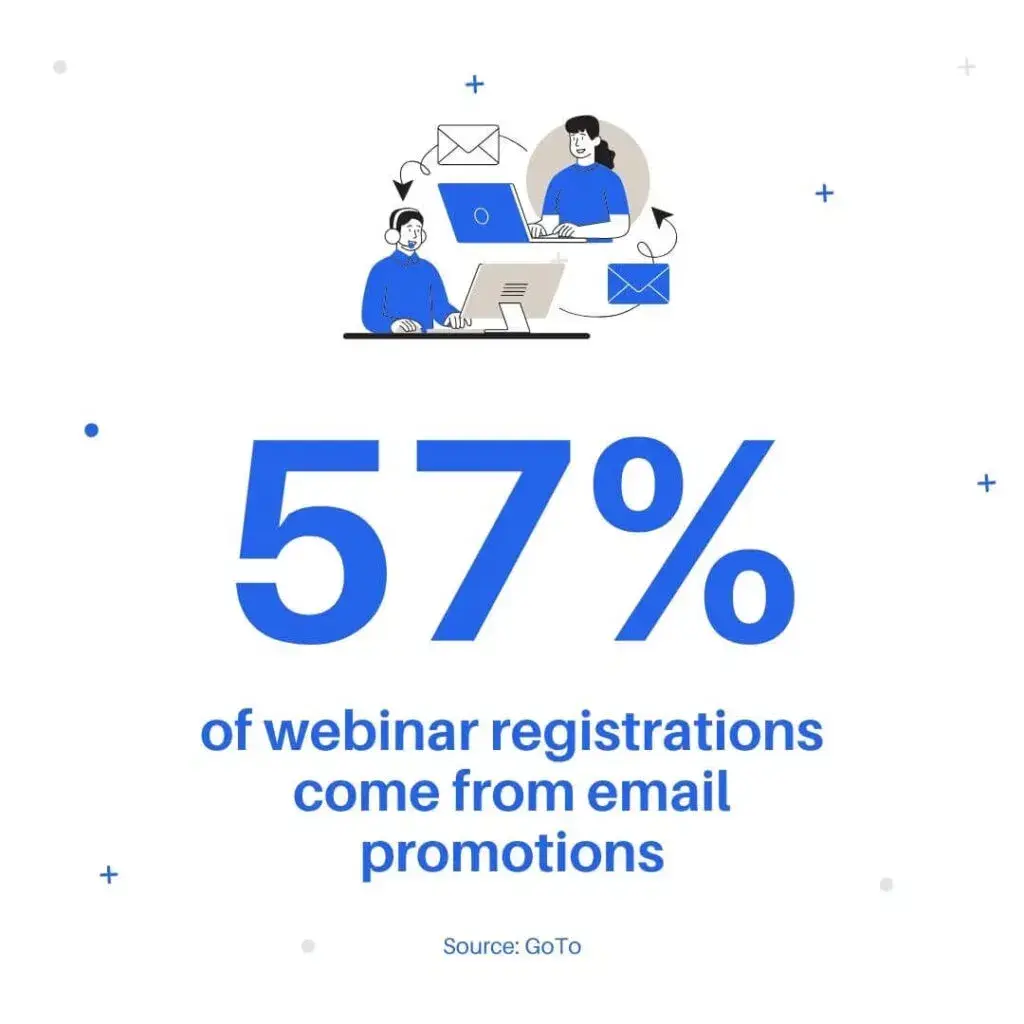
Let’s look at some email best practices for webinar promo.
7. Send a thank you email and registration confirmation.
Sending a thank you email isn‘t just good manners — it also gives you a chance to confirm your attendees’ registration (so they know that their form submission worked) and, you know, remind them about your webinar.
Some people will delete it. Some people will save the email in their inbox, serving as a periodic reminder of your webinar. Some people will take the details in the email and input it on their calendars. If any of your registrants fall into those last two groups of people, you‘re sittin’ pretty.
Top tip: Include a call-to-action “Add this webinar to your calendar” as the #1 CTA in your thank you and follow-up emails.
8. Send value-building reminder emails.
Send these two weeks in advance, and one week in advance of your webinar. They not only remind registrants about the webinar's date and time but also rebuild the value you established with them on your registration landing page.
Many of your registrants may have forgotten not only that they registered for your webinar but also why they registered in the first place.
Are you ready for next week?
Hi [REGISTRANT NAME],
We‘re 7 days away from the [WEBINAR NAME], where you’ll learn to [GOAL/VALUE PROPOSITION OF EVENT].
Here's a quick reminder of the details of this webinar:
[EVENT DETAILS IN BULLETS]
Before showing up, check out this resource [LINK] on [TOPIC], which will be informing our discussion. Attendees tend to get more out of the event with this knowledge in their back pocket.
Tweet us at [HASHTAG] if you have any questions.
We're excited for you to join us on [DAY]!
Cheers,
[YOUR NAME]
Include relevant blog posts or previous ebooks or webinars that cover similar topics. You might frame this as content your team has recently updated, which they can learn more about in the webinar. Include the webinar's hashtag and tell people to message you if they have any questions.
9. Send two final reminder emails.
People forget. Things come up. Last-minute reminder emails — specifically, one the day before and one the day of — give people enough time to find attendance around meetings and other items on their to-do list, but also not too much time for them to forget about the webinar. It's only a day (or less!) away, after all.
Webinar planning is like any other event, with lots of things to do and stuff to organize. To ensure that you don't forget this important aspect of promotion, marketing automation can come in handy. HubSpot's Workflows tool includes a "Center on date property" that can help you build a drip sequence that leads up to the day of the webinar. This allows you to schedule all the emails at once and leave the worry behind once and for all.
Webinar Promotion Tips That Use Your Website
10. Create an informative landing page.
Be clear. Be honest. Set expectations. Take a look at the landing page created for HubSpot’s webinar with Rajan Kapoor of Dropbox:

This landing page is effective because HubSpot has clearly outlined a few things:
- Who? Introduce presenters on the landing page with brief bios that explain who they are and why they matter. (Well, why they matter for this webinar, at least.)
- What? Include an explanation of what the webinar is about and some of the topics it will cover. Bullet points are best. Pick a dedicated hashtag for your webinar and include it, too.
- When? Seemingly obvious, but ensure you provide a date and time so people can mark their calendars.
- Where? Clearly explain when and how the webinar will be accessible. Typically, webinars are accessible via links and can be joined 30 minutes prior to the start time.
- Why? Explain the value of your webinar. What will people be able to do after they leave your webinar that they weren’t able to prior to attending?
Another excellent landing page is Kocho’s page. As mentioned above, Kocho is using webinars as part of its SEO strategy. These recorded, done-and-dusted webinars serve as a lead-generation tactic with compounding gains from SEO.
Since Kocho knows people are still looking for this page and the webinar via Google, they’ve capitalized on it and included a call to action.
After all, Kocho knows precisely why someone has clicked their page, and they may be able to turn a webinar viewer into a paying customer.
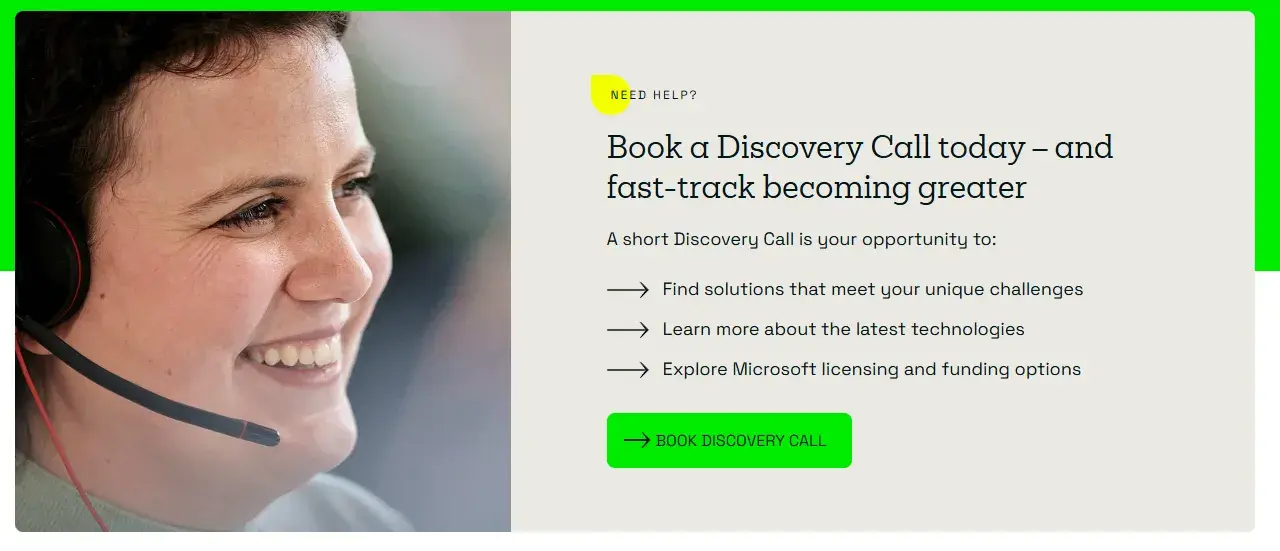
Top tip: When titling your webinar landing page, do some SEO research to see which keywords you want to rank for. Use that same title for subsequent blog posts and SlideShares, and you'll end up with a slew of assets to back up that keyword ranking.
11. Blog about your webinar.
Leading nicely from the Kocho-inspired webinar promotion tip to use SEO, you should also use your blog (and other blogs if you have the relationships) to promote your webinar and the topic it covers.
Create a “launch blog post” for your webinar, indicating the excitement of the new content and data. The post should also provide links to the registration landing page and include a webinar-specific CTA at the end.
You can also get your audience warmed up to the webinar topic by creating blog content that discusses that topic at different angles. Include the webinar CTA in these posts as well, but be sure to swap it out with a different CTA once the webinar is over.
Robert Portillo, CEO and founder of 12 Adaptive Marketing, promotes webinars using various marketing tactics, including the blog.
Portillo says, “I managed a campaign for a law firm client. We created a mix of blog posts, social media snippets, and engaging video teasers weeks before the webinar. The content addressed specific legal challenges their audience faced, leading to a 40% increase in registrations.
Direct engagement is crucial, so I encourage my team to interact with commenters on social media, stimulating conversation and interest. Post-webinar, we maintain momentum by creating follow-up content that highlights key moments and insights, leading to additional sessions and solidifying our brand's value.”
Bonus tip: If you start writing posts about the webinar topic far enough in advance, you can use the questions readers ask in the comments section to beef up your presentation.
12. Leverage your homepage.
Your homepage is likely one of the most visited pages on your website. So why wouldn’t you leverage your homepage real estate to promote upcoming webinars?
It's a great way to show people that your entire company is behind the webinar and sees the value in it for site visitors. Don’t hide behind your webinars; get them out publicly and show people that your company believes in the initiative.
Webinar Promotion Tips for Marketing Channels
13. Give attendees something special.
Try to think of things that will get people excited and feel special, talk with colleagues, and remember their experience on your webinar in the future. Excited registrants turn into excited attendees.
HubSpot has given away event tickets, free marketing assessments, and ad-spend coupons on Facebook and LinkedIn. It has also inspired audiences by asking them to participate in something huge, like breaking a world record.
Matthew Goulart, founder of Ignite Digital, believes in the power of webinars that feel special.
He says, “I think webinars are effective when they're seen as something worth attending, not something you just throw together.
“We've done pretty well with RSVP-only Facebook Events and LinkedIn groups for creating buzz. The strategy lets the webinar appear as a community event rather than a sales pitch.
“In a recent webinar, we featured industry veterans as live speakers and teased their participation in promotions. We doubled our social post engagement and saw a 30% increase in signups.”
With RSVP-only events, I can see how a webinar would feel more special, and community-led. It feels like a commitment from both sides (host and attendee) is being made.
Goulart also believes that personalization is impactful. He says, “I believe personalization also helps — sending emails with subject lines highlighting attendees' specific struggles got better open and conversion rates.”
What I like about this: We all know that webinars are created for a reason — ultimately to sell something — but if you can make your audience feel more special, it will go a long way! It’s worth showing your audience that this isn’t just another sales pitch; it matters who shows up, and they’ll get something valuable out of it.
14. Run contests on social media that also promote the webinar.
You can run social media contests that help with webinar promotion, such as asking attendees to post something on social media related to the webinar a week in advance and picking the winner at the beginning of the webinar.
For example, HubSpot held a #WorkRemote hashtag challenge to support a webinar on working remotely effectively. They also built a landing page explaining the rules and how the winner would be chosen.
Note: Be sure to work with your legal team when planning any challenge or contest.
You could note in the promotional and reminder emails that “attendees are getting a special 25% discount on X,” and include that discount code in the final slide of your webinar.
To make things easy, consider using Rybbon, a system that can help gift rewards to webinar participants.
Hashtags are powerful for webinar promotion. Elmo Taddeo, CEO of Parachute, creates hashtags for webinar events. Taddeo says, “On social media, we post consistently across platforms like LinkedIn, Facebook, and Instagram, increasing frequency as the event nears. X works especially well for multiple reminders, and creating a unique hashtag helps foster engagement during and after the event.”
Why I liked this: This is a fun and friendly way to increase the visibility of your webinar. If it goes well and there is a lot of hype about it, you can reach a lot more people than you could without it. Plus, your audience will be marketing for you!
15. Market your webinar using social media.
You know what‘s awesome about social media? It’s much more difficult to oversaturate your social audience than your email audience.
And there's a good chance much of your email audience is connected with you socially, too. That affords you the opportunity to use social media to remind your audience about your webinar.
If you're using a social media publishing schedule, you can pepper in updates for every social channel reminding your audience that you have an upcoming webinar. Increase the number of reminder updates as the date approaches, particularly the day before and the day of.
Make sure you pick a dedicated hashtag for your webinar and include it on the landing page, in your emails, and everywhere else you promote it.
16. Don't be afraid of paid media.
If you’re looking to drive more attendees to your webinar and have the budget, a little paid media to supplement your organic efforts can always help. For instance, you might run a pay-per-click (PPC) ad on Google for a search term that aligns with your webinar content in order to get the word out and drive attendance.
By bidding on a long-tail keyword such as “aligning sales and marketing,” you can also keep your PPC costs low, promoting your webinar cost-effectively.
Just make sure your paid media and organic teams are aligned so your company is organically publishing terms like “aligning sales and marketing” while you bid on the same term, resulting in total dominance in the SERPs for that keyword phrase.
Mushfiq Sarker, CEO of LaGrande Marketing, has some data-driven insights regarding the performance of paid webinar ads.
Sarker is a marketer who has promoted law firm webinars using various marketing channels, such as social media, emails, and ads. He says the best results came from retargeting ads, which allowed him to re-engage with website visitors who had shown interest but hadn't registered yet.
When asked how to get the most out of ads, Sarker says, “The ads included a clear call to action and urgency, highlighting that seats were filling up quickly and encouraging immediate registration, paired with testimonials from past webinars.
“To keep the campaign cost-effective, we capped the frequency to avoid overwhelming users while still staying on their radar. About 30% of our total webinar registrations came from retargeting ads, and these leads participated actively during the webinar, asking questions and reaching out afterward for consultations.”
The results of Sarker’s webinar promotion tips are impressive. Sarker says:
“Compared to other methods like email campaigns or organic social media posts, retargeting gave us the highest conversion rate for the budget spent. Emails drove some registrations, but the open rates averaged around 25%, and click-through rates were closer to 2%. Organic posts, while good for initial awareness, didn't directly bring in as many signups.”
Sarker believes that an ads strategy works because it “targets people who are warm leads, capitalizes on existing interest and pushes them to take action.”
Why I like this: Paid media such as PPC are perhaps one of the most reactive forms of marketing. It is highly measurable and as Sarker demonstrates, you can target granular audiences who are likely to sign up.
.png)
Free Webinar Planning Kit
Run better webinars with this kit, including the following assets:
- Guide on Building a Webinar
- Marketing & Sales Alignment Strategies
- Webinar Planning & Strategy Template
- Interactive Webinar Planning Checklist
Download Free
All fields are required.
.png)
Webinar Promotion Tips Using Your Network
17. Market your webinar through your speakers.
Of course you'll be promoting your webinar, but what about the presenters? You know, the ones with a different audience than yours right at their fingertips? Are they leveraging their personal connections, social accounts, and email lists to make sure they have a giant audience? If they‘re not, they sure-as-shootin’ should.
Tom Haberman, CEO and creative director of Studio4Motion, speaks to the value of cross-promotion for his webinars. In fact, cross-promotion helped garner a 40% increase in sign-ups.
It’s worth noting here that cross-promotion is not hard work for anyone because you can reuse assets; all the speaker has to do is share the asset.
Haberman says, “We often create a LinkedIn Event for our clients, which allows our network to easily RSVP and see updates. We share teaser graphics or short video clips featuring the webinar's key points, and we encourage our guest speakers or collaborators to do the same.
“This cross-promotion can expand reach significantly. One of our latest clients saw a 40% increase in sign-ups by having a co-presenter share the event on their LinkedIn feed.”
Pro tip: Whenever I’ve appeared on a podcast, webinar, or audio event, the host has provided me with the assets I used to share across my socials. I do think this is effective. Although I will always share events I’m a guest on, I may not always find the time to create compelling imagery alongside it. Providing the assets is good practice since it removes friction and increases the chances of a share.
Generally, I’d advise giving the speaker or guest creative license to write whatever they’d like since you want the post to read authentically to their audience but you could write a draft if you wanted to remove more friction and save them time.
18. Use speaker headshots to promote your webinar.
Two webinar promotion pros came to me with the idea of using headshots to promote the webinar, and I loved it!
Headshots have always been used whenever I’ve appeared on webinars or within podcasts and blogs, and I can see how effective they are for webinar promotion. Your speakers are one of the major reasons why people attend webinars, so leading with them may capture the attention of the people who most like them.
Tomas Melian, SVP of marketing at MyHealthTeam said, “You really need the speaker to offer at least some headshots for invitations because it makes them far more relatable — it's helped us pull far better conversion rates on signups.”
Here’s an example from a free HubSpot webinar where the thumbnail leads with a speaker’s image.
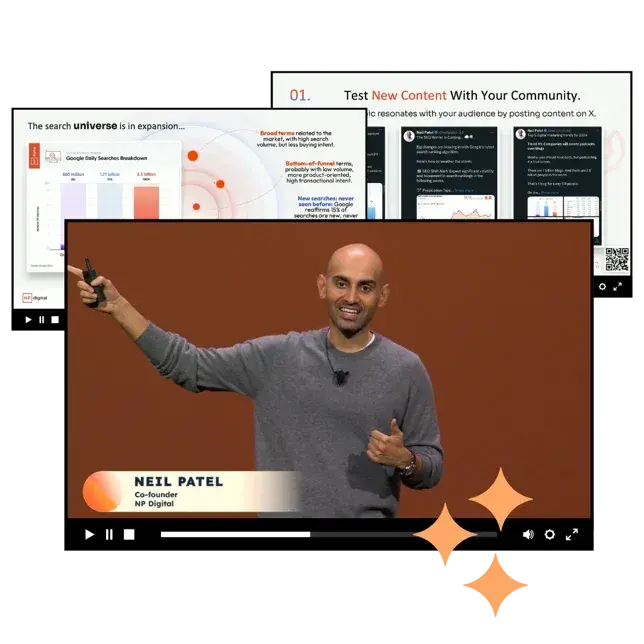
19. Partner up.
If you want more people to attend your webinar, you can always consider working with another brand. But while additional attendees are one benefit, it shouldn’t be the main focus of partnering up — relevancy, however, should be.
For example, HubSpot has partnered with numerous partners (see Neil Patel above). While this partnership has marketing purposes, the two are also well-aligned brands and have the power to be truly amazing together — much more amazing than they can be apart.
It‘s also helpful for your audience to hear another perspective once in a while, particularly when that perspective comes from a specialist’s point of view.
Best Practices to Get the Most Out of Your Webinar Promotion
20. Choose the right day of week.
Don‘t host your webinar during the weekend. Okay, you probably knew that one. But did you also know that it’s best to host your webinars on Tuesday, Wednesday, or Thursday?
The day (and time, but we’ll get onto that next) significantly impacts the success of your webinar and the promotion. Not even the best webinar promotion tips can save a webinar hosted at a time or date that doesn’t suit the audience.
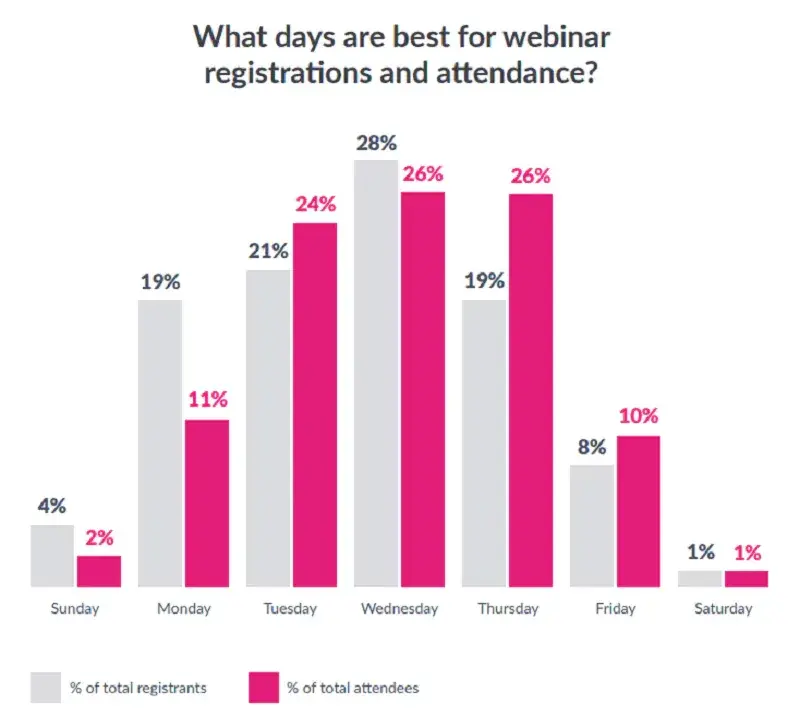
Monday and Friday always seem to get filled up with “catch-up” and “last-minute emergency” happenings around the office.
According to Influno, Wednesday and Thursday are the days people are most likely to attend webinars. Both Wednesday and Thursday attract 26% of attendees.
Tuesday comes in third at 24%, which validates the Monday/Friday hypothesis.
21. Choose the right time of day.
HubSpot typically runs webinars at 1 p.m. EST or 2 p.m. EST because it's the most convenient time for the largest chunk of their audience. But if you have a massive audience in another part of the world, you’ll want to reevaluate your timing based on their time zones.
If you’re unsure what time works, a best practice tip would be to ask. Include a field on your registration form that asks attendees to confirm the best time slots for them and schedule your webinar based on that feedback.
Alternatively, there’s some evidence from Influno that 10:00 am and 11:00 am work best.
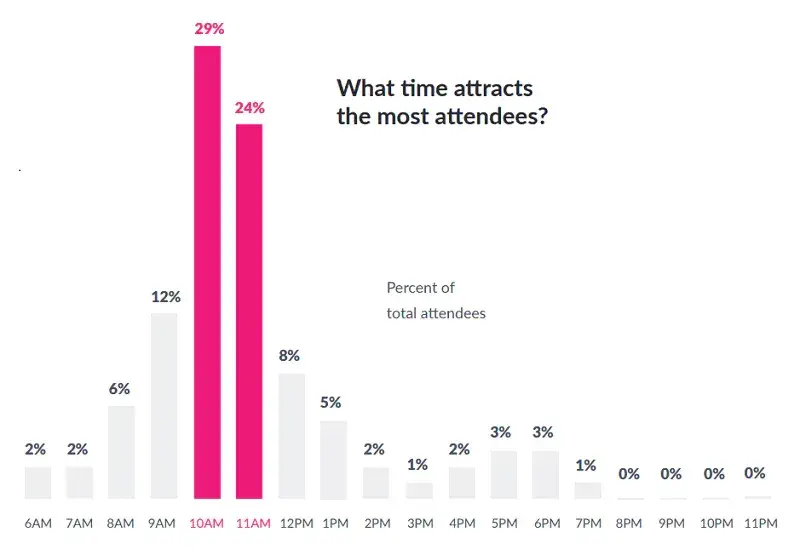
Top tip: Like any variable in marketing, the best time (and day) will depend on your audience. Which time zone(s) do they live in? Do they work nine-to-five jobs, or are their daytime schedules more open? To maximize attendance, experiment with different days and times, compare attendance rates and conversion rates and tweak your timing accordingly.
22. Set calendar reminders.
Some uber-organized people will put your webinar on their calendar, but there are tools out there that let you take it a step further.
23. Use the best video conferencing tools to ensure a smooth video experience.
If an industry expert reveals the secret to success, but their technology isn't good enough to record it, did they make an impact?
The content of your webinar might be unparalleled industry insight, but it isn‘t nearly as valuable if your attendees can’t easily access and listen to the event. Picking the right video conferencing tool puts your webinar on the platform it deserves, so people are encouraged to join in and listen to you.
Here are some reliable webinar hosting services to choose from.
Loom
Loom is a video recording software, compatible with Mac, Windows, and Chromebook computers. The tool offers a convenient desktop app and can record your screen activity in real time. Loom is particularly useful for pre-recorded webinars, slide presentations, and single-hosted experiences.
Zoom
Zoom is a cloud-based conferencing tool that offers live and on-demand video services. You can use a Zoom account to add a video chat option to group events listed on your online calendar.
GoToWebinar
GoToWebinar helps you create branded webinars with automated email invitations leading up to the event. It also makes it easy to follow up with attendees after the webinar, while reporting on who attended and who didn't.
Customers buy from the companies they can trust, and broadcasting your industry expertise via webinar is one of the key ways of doing that.
Riverside.fm
I had to include Riverside.fm here because I’ve used it for podcasting. I’ve been a guest of two podcasts using this software, and it is easy to use and intuitive and helps with recording and sound quality.
24. Don’t be afraid to be yourself and be entertaining.
An authentic host delivers a great webinar.
Although webinars might be on business or industry trends, you can still be yourself and must be engaging and/or entertaining. This will help engage audiences, and without a layer of entertainment, your attendees might think of your webinar as a 40-minute opportunity to catch up on emails.
After all, that verbal component is what makes webinars so unique: There are few other mediums where you can deliver content that lets your personality shine through to such an extent.
It‘s really easy to create webinar content with only your end goals in mind — that point you want to get across or those things you want to talk about — but that won’t keep your audience engaged.
Think carefully about who your audience is while crafting your webinar content. At the end of the day, your webinar is about building connections and relationships with your audience so they trust you that much more.
When the webinar is over, you can clip the most engaging or entertaining sections and use them in post-webinar promotions.
25. Host mini Q&A sessions.
Matías Rodsevich, founder & CEO at PRLab, reports webinar promotion success from hosting mini Q&A sessions with speakers.
He says, “We host mini Q&A sessions or share short clips of our speakers discussing key topics. These sneak previews generate excitement without giving away the entire agenda. For one webinar, a live Instagram Q&A preview increased registrations by 30% within a week.”
26. Create clips and teaser content.
Peter Lewis, CMO at Strategic Pete, echoes Rodsevich's words but expands on the value of clips and teaser content.
Lewis says, “We‘ve had great success starting with LinkedIn as the launchpad. It’s the ideal platform to create anticipation with value-added posts — create a series of posts leading up to the webinar, including teaser clips, polls on the topic, or even questions your audience wants answered.
“For example, instead of just announcing the webinar, we turned the topic into a conversation starter: ‘8 out of 10 prospects don't trust your marketing.’ By framing the webinar around a problem most people experience and promising actionable solutions, like showing exactly how to use case studies to build trust, we doubled sign-ups with just this one post.”
In one post, Lewis reports:
- 351 impressions.
- 198 members reached.
- 82 video views.
- 61 unique viewers.
- 140 minutes total watch time.
Lewis says, “Not bad for a single LinkedIn post focused on the problem rather than the event itself.
“After the live, we shift focus to on-demand access via our website. We make it free but add value by pairing the video with downloadable resources like templates, scripts, or workflows mentioned in the session. Don't make it feel like “just another webinar.” Turn it into a resource that solves a real problem.”
27. Don’t gatekeep your most valuable webinar assets and points.
Webinars generally have an educational component, whether you're educating your audience about a product, a service, a new piece of content, how to use a tool, and so on.
During the promotional phase, you might be tempted to keep the most valuable webinar points to the webinar itself, but sharing your points in the form of a hook is a great way to capture your audience's attention during the promotion phase.
You want your audience to know what they’re getting from the webinar and to be motivated and excited to join, so don’t bury the best stuff!
Rodsevich (mentioned above) said it best when he said, “Offer value upfront. Let attendees feel they're already learning before committing.”
Why I like this: It can be tempting to gatekeep information, but you should provide value upfront. Most of my marketing is organic and results in inbound leads because I provide value upfront. I’m not afraid to share the best of my knowledge. It works.
Start Promoting Your Webinar
I loved the insights from these seasoned webinar hosts and marketers sharing their best webinar promotion tips.
Undoubtedly, cross-network promotion worked best.
Marketers seem to use a range of platforms and have a plan throughout the webinar production timeline, from pre-production to the event itself and then post-production, to get the most out of the webinar as long-term assets that will continue to work for your business after the event.
Personalized marketing seems to be the way to go, and this wasn’t surprising to me as I’ve seen the value in personalizing content and using speaker headshots to generate engagement.
Editor's note: This post was originally published in August 2012 and has been updated for comprehensiveness.
.png)
Free Webinar Planning Kit
Run better webinars with this kit, including the following assets:
- Guide on Building a Webinar
- Marketing & Sales Alignment Strategies
- Webinar Planning & Strategy Template
- Interactive Webinar Planning Checklist
Download Free
All fields are required.
.png)
Webinars










![How to Write a Webinar Script [+ Template]](https://53.fs1.hubspotusercontent-na1.net/hubfs/53/181_Write-a-Webinar-Script.png)
![Why Consumers Sign Up for Webinars [New Data]](https://53.fs1.hubspotusercontent-na1.net/hubfs/53/why-do-people-sign-up-for-webinars.jpg)